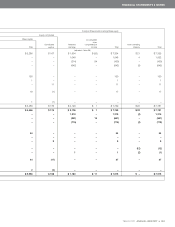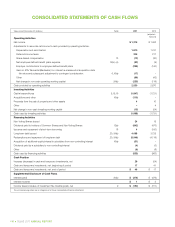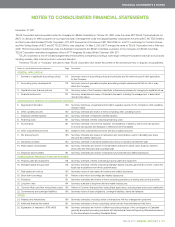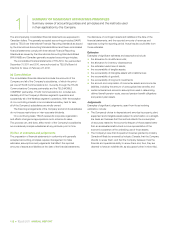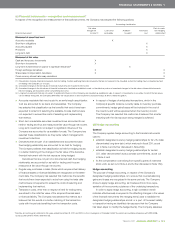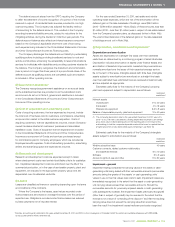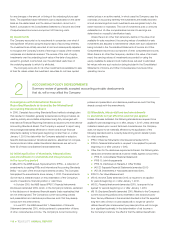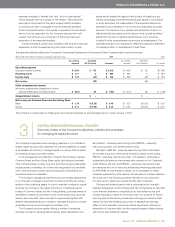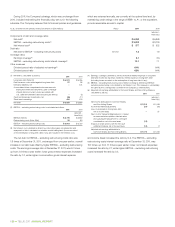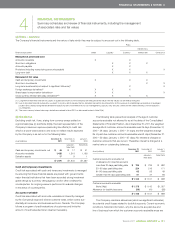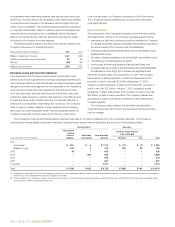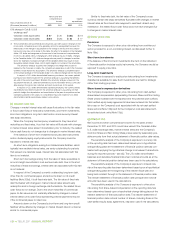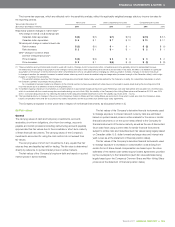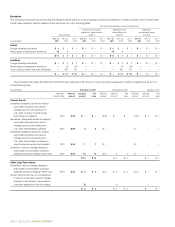Telus 2011 Annual Report Download - page 123
Download and view the complete annual report
Please find page 123 of the 2011 Telus annual report below. You can navigate through the pages in the report by either clicking on the pages listed below, or by using the keyword search tool below to find specific information within the annual report.
TELUS 2011 ANNUAL REPORT . 119
FINANCIAL STATEMENTS & NOTES: 2 – 3
expense concepts of “interest cost” and “return on plan assets”
will be replaced with the concept of “net interest”. Net interest for
each plan is the product of the plan’s surplus (deficit) multiplied
by the discount rate. Unchanged is that the amended standard
does not prescribe where in the results of operations the net interest
amount is to be presented, but the Company expects that it will
present such amount as a component of financing costs upon
application of the amended standard.
As the Company’s current view, consistent with long-term historical
experience, is that the expected long-term rate of return on plan
assets would exceed the discount rate (a result of targeting a sig-
nificant percentage of the defined benefit plan assets to be invested
in equity securities), the relative effect of the amended stan dard is
expected to be a decrease in net income and associated per share
amounts. The variance, if any, between the actual rate of return on
defined benefit plan assets and the discount rate, as well as related
effects from the limit on defined benefit assets, if any, would be
included in other comprehensive income as a re-measurement. The
amended standard is not expected to affect the Company’s statement
of financial position or the statement of cash flows.
The amended standard affects the Company’s Consolidated Statements of Income and Other Comprehensive Income as follows:
Years ended December 31 (millions except per share amounts) 2 0 11 2010
As currently Amended As currently Amended
reported IAS 19 effects Pro forma reported IAS 19 effects Pro forma
Operating expenses
Employee benefits expense $ß1,893 $ß 113 $ß2,006 $ß1,906 $ß 82 $ß1,988
Financing costs $ 377 6 $ 383 $ 522 5 $ 527
Income taxes $ 376 (30) $ 346 $
335 (22) $ 313
Net income (89) (65)
Other comprehensive income
Item never subsequently reclassified to income
Defined benefit plans re-measurements $ß (851) 89 $ß (762) $ß (214) 65 $ß (149)
Comprehensive income $ß – $ß –
Net income per Common Share and Non-Voting Share
Basic $ß 3.76 $ß(0.28) $ß 3.48 $ß 3.27 $ß(0.20) $ß 3.07
Diluted $ß 3.74 $ß(0.28) $ß 3.46 $ß 3.27 $ß(0.20) $ß 3.07
The Company currently plans to initially apply the amended standard for periods beginning on or after January 1, 2013.
3CAPITAL STRUCTURE FINANCIAL POLICIES
Summary review of the Company’s objectives, policies and processes
for managing its capital structure
The Company’s objectives when managing capital are: (i) to maintain a
flexible capital structure that optimizes the cost and availability of capital
at acceptable risk; and (ii) to manage capital in a manner that considers
the interests of equity and debt holders.
In the management and definition of capital, the Company includes
Common Share and Non-Voting Share equity (excluding accumulated
other comprehensive income), long-term debt (including any associated
hedging assets or liabilities, net of amounts recognized in accumulated
other comprehensive income), cash and temporary investments and
securitized accounts receivable.
The Company manages its capital structure and makes adjustments
to it in the light of changes in economic conditions and the risk charac-
teristics of the underlying assets. In order to maintain or adjust its capital
structure, the Company may adjust the amount of dividends paid to
holders of Common Shares and Non-Voting Shares, purchase shares for
cancellation pursuant to permitted normal course issuer bids, issue new
shares, issue new debt, issue new debt to replace existing debt with
different characteristics and/or increase or decrease the amount of trade
receivables sold to an arm’s-length securitization trust.
The Company monitors capital utilizing a number of measures,
including: net debt to earnings before interest, taxes, depreciation and
amortization – excluding restructuring costs (EBITDA – excluding
restructuring costs); and dividend payout ratios.
Net debt to EBITDA – excluding restructuring costs is calculated
as net debt at the end of the period divided by twelve-month trailing
EBITDA – excluding restructuring costs. This measure, historically, is
substantially the same as the leverage ratio covenant in the Company’s
credit facilities. Net debt and EBITDA – excluding restructuring costs
are measures that do not have any standardized meanings prescribed
by IFRS-IASB and are therefore unlikely to be comparable to similar
measures presented by other issuers; the calculations of these measures
are as set out in the following schedule. Net debt is one component
of a ratio used to determine compliance with debt covenants.
The reported dividend payout ratio is calculated as the quarterly
dividend declared per Common Share and Non-Voting Share, as recorded
in the financial statements, multiplied by four and divided by the sum
of basic earnings per share for the most recent four quarters for interim
reporting periods (divided by annual basic earnings per share for fiscal
years); the reported dividend payout ratio of adjusted net earnings
differs in that it excludes: income tax-related adjustments; the loss on
redemption of long-term debt; and the ongoing impacts of share options
with the net-cash settlement feature.


